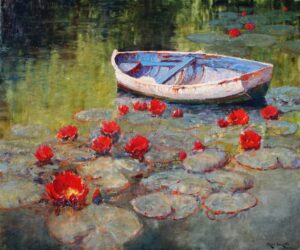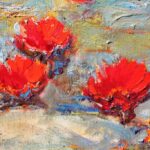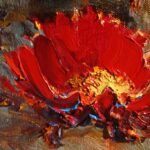
I always use a very high quality, pre-primed, heavy-duty linen canvas by a leading manufacturer. I also choose a very coarse linen. Why? When observed very closely, the surface of such canvas is a series of round bumps linear in both directions.
Once I have suggested the drawing, or perhaps more correctly the positioning of my masses, I like to color the canvas with a wash of chosen color. I never use pure turpentine, only because it denies any body in the pigment in places on the canvas where no other paint will cover this wash which, without the addition of oil, will not survive time.
At this point in the procedure, I have no white or opaque colors on my palette. The result is an effect as pure in color as a watercolor on white paper. Often the most gorgeous colors are dark and intense. Here I might bypass the wash and apply the pigment without medium. Then because I require a lift in the tone or lightness of an area, I use a knife to scrape off most of the paint. Now because the canvas has all its multiple mini-projectories, the paint will be left only in the recesses of the canvas. So, actually what happens is that the white of the canvas bumps is seen through the applied pigment. From very close, it appears spotty, but from afar, the eye reads a lighter value of a delightful dark pigment which has in no way lost its transparency or luminosity. Also because the paint is so recessed in the canvas texture, one can apply either a scumble or impasto without drying time.
At this point, I normally choose to scumble, also because being so thin and adhering to the canvas projectories only it will harden quickly. Until I really have my picture talking to me, I don’t choose to paint wet in wet.
What I’m describing is more for large canvasses in one’s studio. Plein air small works don’t belong to this category. Small plein air, one tends to go in fully loaded. There is too much wind and way too many bugs to do anything else.

Scumbling, a very light touch to the canvas with a large flat brush using undiluted paint, will offer numerous effects but never totally cover the wash or the scratched areas. Otherwise, why bother to put them in, in the first place. Every stage is part of the finished painting.
Now comes the impasto. For some reason or another, lumpy paintings have become the vogue. The idea of a lump on a canvas is that under angular lighting, a lump will catch the beam of light and visually leap off the canvas. Now this is great for highlights in high-toned colors. If the painting is ultimately varnished, your lumps will “shine” as well under spotlights. If you don’t want shine or glitter, don’t lump. Lumps in a dark area glisten and totally destroy the intensity of the dark. Recently, I saw a show where the whole painting was lumps. Wonderful for the manufacturer but a disaster to the painting – and the viewer!

Painting florals is interesting. A knife is good, but it tends to lose the delicacy and femininity of a petal. As petals of a rose, for example, are so perfect a non-textural finish is needed. No shadows are required in a petal under the sun. A brush stroke will leave fiber striations, which cast minute shadows. A latex gloved finger will give you a petal beyond your expectations. But use a new finger for every application. Otherwise, you will have the most devastating mud pie!
There is no need at any stage of a painting to apply any pigment which will not be seen in the finished work. One can, of course, rub color over another color to create a secondary value – but let’s not get too complicated!
Style vs. Technique

An individual style, while part of the artist’s being, can contain a multitude of technical approaches and variations. Thus, technique is the systematic procedure by which the style is conveyed.
We all come into this world as human babies, yet with us, we carry the subconscious skills and memory of a million lifetimes. Parents often believe that they guide and direct their children – perhaps they do. Yet so often children display an aptitude, which is totally foreign to the abilities and ideals of the parents. Inherent subconscious abilities mingle with the new enforced dogma of pre-schooling to mold individual style or character of youth. Then, of course, there is the astrological approach. If you are a Virgo, the chances are you will become a more gentle and precise person than your brother or sister, who is a Sagittarian or Leo. These will often all but challenge life, and are more subjective, possibly less affected by the external world.
In the art world, the Sag or Leo will marvel at the patience and dedication of the Virgo, while the latter is impressed with the out of space creative ability of the former.
Essentially, all this is just words. As individuals, we have become what we have become, for better or for worse. There is little we can do about this, but we can make good use of it.
Conversely, we can discuss technique in art. Here we energize our mental faculty. We can take a shot at any technique out there. It is what each one likes, or perhaps more correctly finds easiest. One’s choice of subject matter is often governed by individual ability. For example, if one has a natural aptitude for realistic drawing, then portraits drawn or painted will be appealing.
The choice of watercolors or oils is often considered. This is definitely a technical choice. Watercolors demand a fluidity and accuracy. Then again, often the most successful watercolor is an accident.
Of oil painting, I often hear that folks like the freedom of scratching the paint off, or simply painting over the initial effort. Actually, I personally don’t buy this concept, it is just plain too messy. A good oil generally starts off clean and simply stated. It requires time to harden and is then completed.
At this point, let us revise. Style is what we are. Technique is a mental playground, it can go anywhere.
So, here is a technical suggestion. On the understanding that we love the joy of transparent watercolor on white paper, yet we are equally infatuated with the loading of impasto oils. Why not combined these two?
Loading watercolors doesn’t work too well. One tends to get a very dark image. I used to do this as a child, but this system is very extravagant and, needless to say, expensive. Adding white to those gorgeous transparent watercolors is a disaster. You might as well just buy gouache colors. But hang on; one of the greatest joys of painting is to portray life as clean and transparent. So stay with watercolors, no white pigment.
Here is the technical suggestion I spoke of earlier. Let us get back to oils. Generally, oil pigments are stipulated as transparent or opaque. For this exercise, transparent colors should be selected. No white paint or opaque colors should be on your palette. Dilute your oils with medium, and paint a very thin layer as you draw. Once you have covered the canvas, stop, and let your work dry. This may take a day or two. After both you and your painting have had a good rest, you are ready to convert your efforts to an oil impasto. Now there is no point in totally covering your transparent lay in. It was good, keep it. There is a technique known as scumbling. Using your oil pigments with as little medium as possible, or none at all, drag your new color over the transparent underlay. A course canvas texture tends to make this easier. The idea being that the visual blend of the scumble color only partly covering your transparencies will yield a vibrant effect. This effect carries twice the emotional and visual excitement of any stirred up blend of color.
So style and technique intermingle. The style is what you are born to do, the technique is what you choose to do!